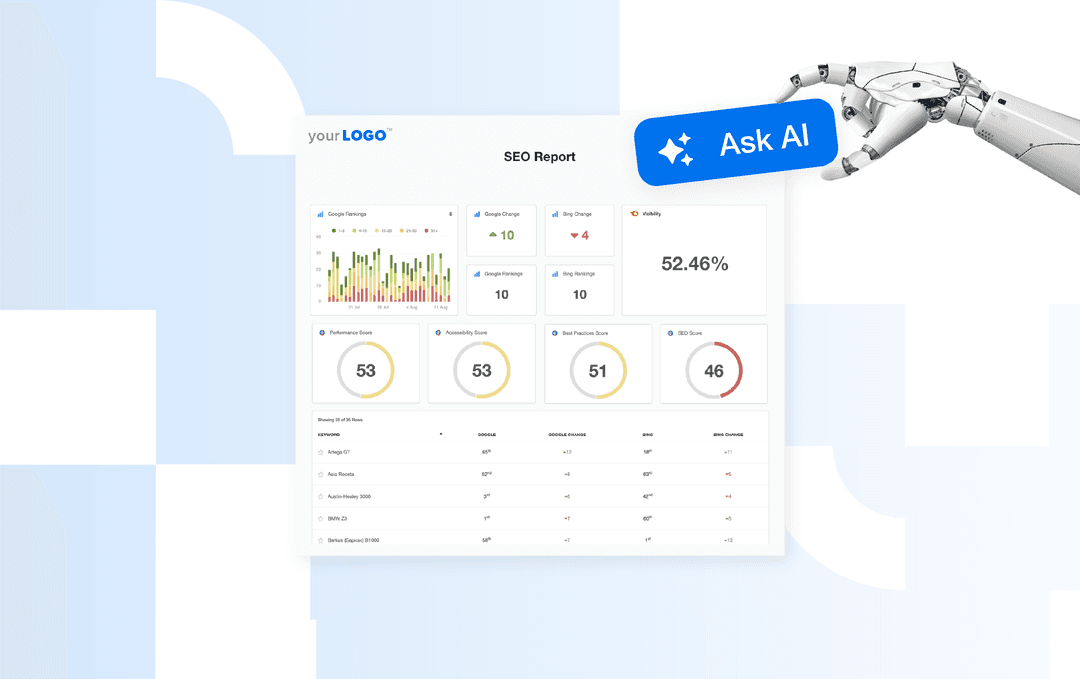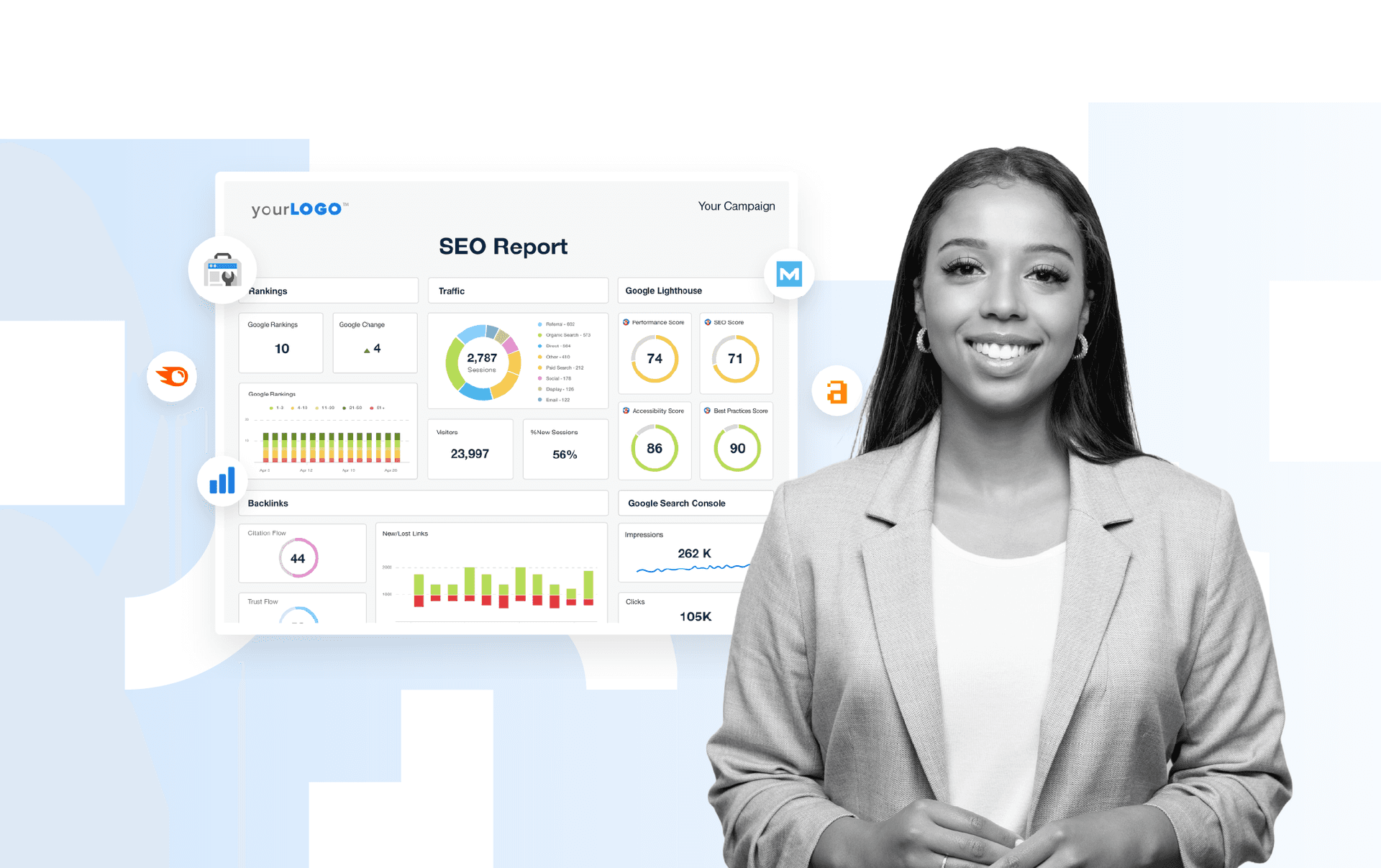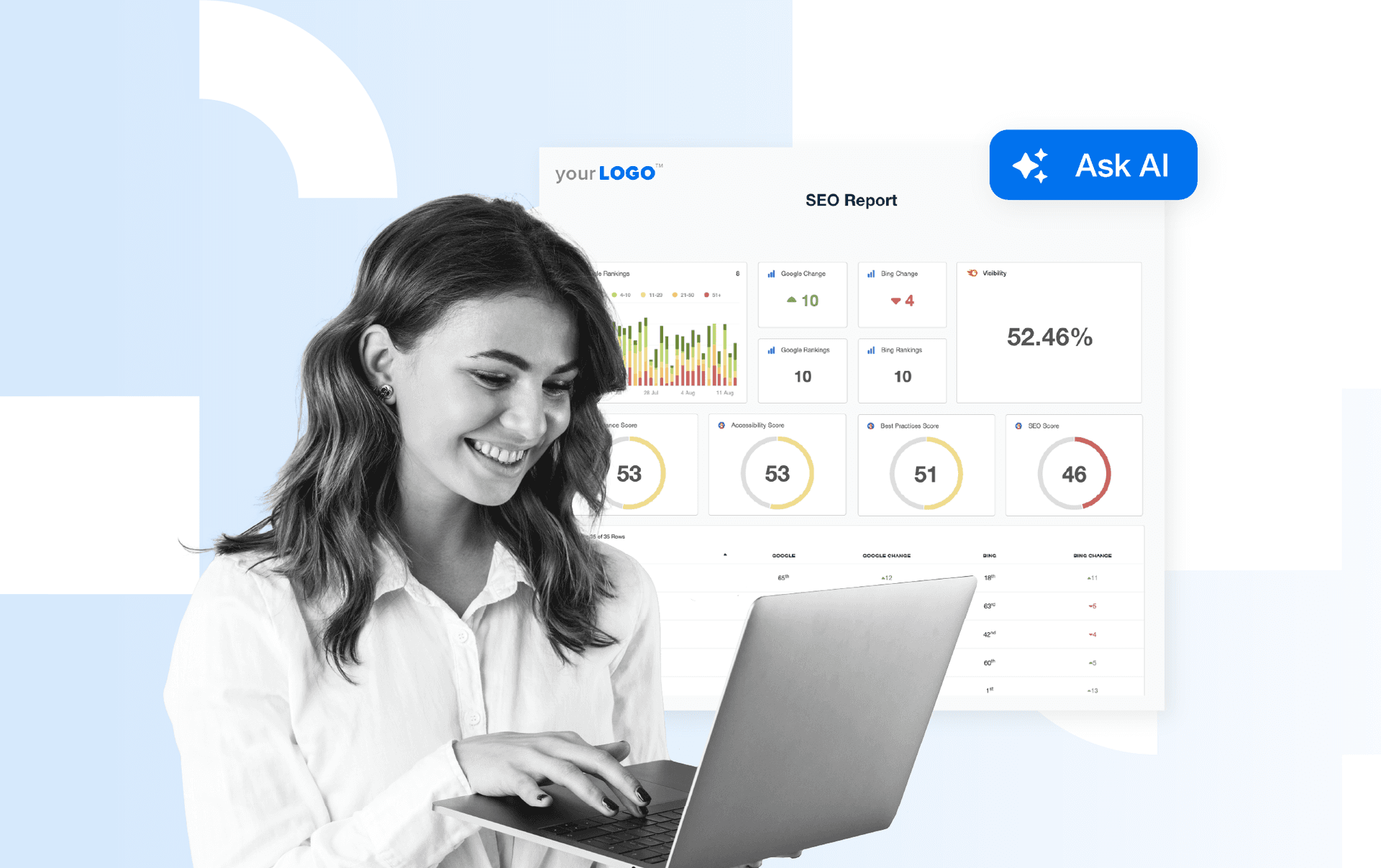Table of Contents
QUICK SUMMARY:
LLMs and generative AI are everywhere in agency life, but what’s the distinction between the two? This guide breaks down how to use AI in digital marketing agencies to speed up delivery, scale creative work, and still keep the human spark that makes it worth paying for.
Large language models (LLMs) and generative AI are talked about like they’re twins, but that’s not entirely correct. Generative AI is an umbrella term that covers a wide range of AI tools that assist in creating content. This includes tools that spin up visuals, videos, code, chats, and written content.
LLMs are the specific branch of generative AI that focus on language–meaning that while all LLMs are generative AI, not all generative AI tools are LLMs.
In this article, we’ll break down what LLMs and generative AI do best, and where they actually belong in your marketing stack.
What is a large language model (LLM)?
A large language model (LLM) is a type of artificial intelligence specifically built to understand human language. If you’ve used ChatGPT, you’ve already seen one in action. The “GPT” stands for Generative Pre-trained Transformer. This means it uses deep learning and vast amounts of training data to spot patterns in how people write and talk. So when it’s given a prompt like “write a LinkedIn post for Cybersecurity awareness week”, it draws on what it’s learned to create text that sounds like it came from a real person.
LLMs can support just about every part of agency life, including:
Content creation: Drafting and editing copy that sounds natural, on-brand, and consistent across campaigns.
Streamlining reporting: Summarizing large volumes of text data and generating clear reports.
Virtual assistants: Powering AI systems that handle day-to-day language-based tasks and client communication.
What is generative AI?
Generative AI (or Gen AI) is the broader umbrella term for all artificial intelligence that learns from text, images, and other data to create something new (including LLMs). While large language models focus on understanding and generating language, generative AI goes broader—additionally producing original content across words, visuals, music, and code.
Think less ‘robot writer’ and more ‘fast prototype machine’ that helps teams explore ideas faster, test concepts before design starts, and keep campaigns moving from draft to delivery without the slowdown.
The emergence of Generative AI in search is both exciting and transformative. It allows searchers to ask more nuanced and conversational questions, similar to having a dialogue with a real person. This shift towards natural language queries means SEO strategies will need to evolve, focusing more on understanding user intent rather than just specific keywords.
Stephan Moerman, Co-Founder, Bakklog
Key differences between LLMs and generative AI
When it comes to generative AI vs LLMs, the difference really comes down to what they create and how they learn to do it. Here’s a quick rundown:
Underlying technologies
LLMs are a type of generative AI built mostly on transformer architectures, a kind of neural network originally developed for natural language processing. They model words, syntax, and context to generate fluent, human-like text (and often code and other text-based formats).
Generative AI is the broader category that includes LLMs and other models. Beyond text, it uses architectures such as diffusion models and, historically, Generative Adversarial Networks (GANs) to generate new content in different formats—like images, audio, and video.
Use cases and applications
LLMs handle language-related tasks: chatbots, virtual assistants, content summarization, and anything that depends on understanding or generating text.
Generative AI handles creation across mediums: image generation, music composition, video production, code generation tools that turn prompts into working prototypes, and yes–language too.
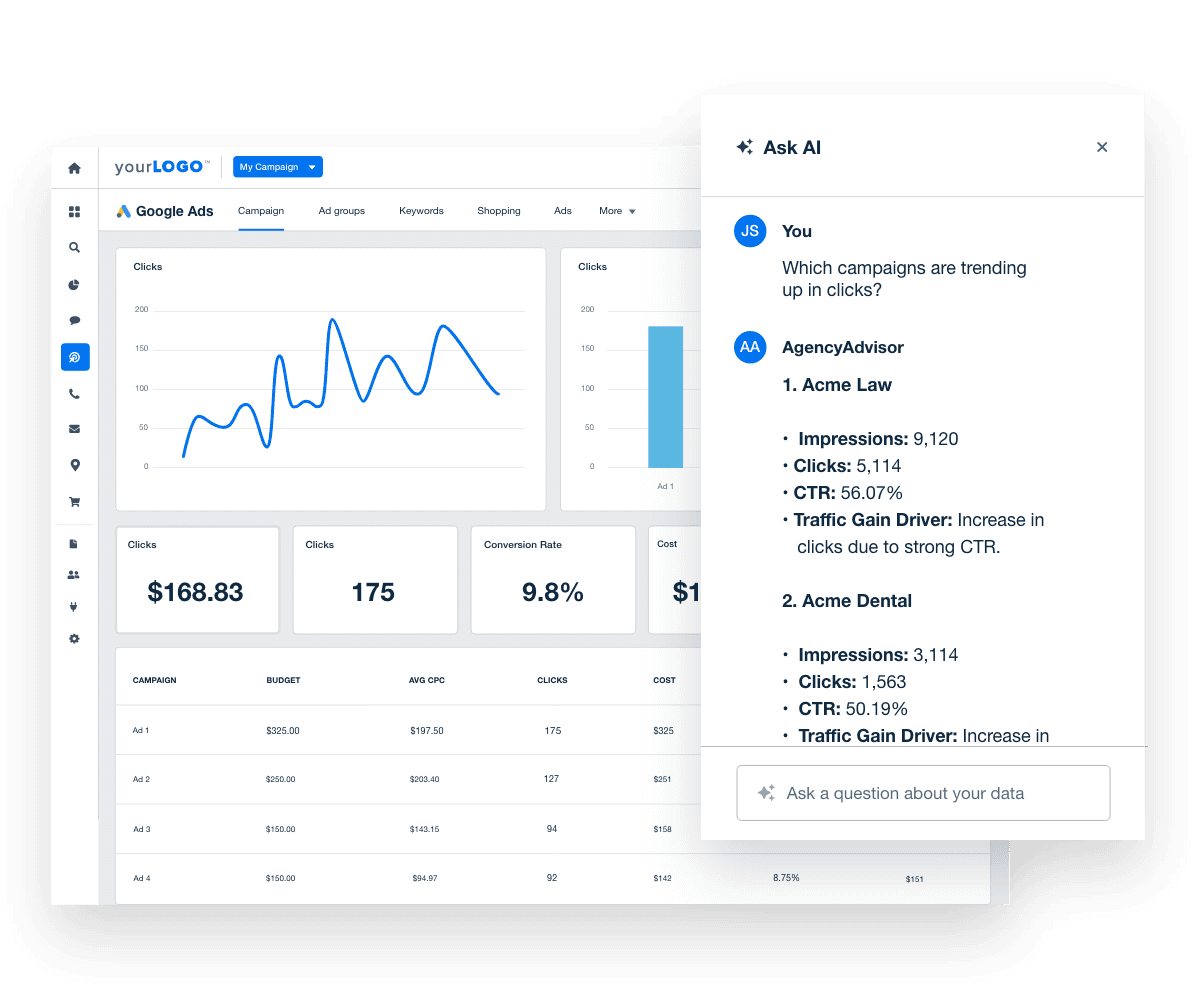
With Ask AI from AgencyAnalytics, it’s easy to surface interesting trends and patterns (or simply further performance details) from your client reports. Save time while proving your agency’s ROI. Sign up for your free 14-day trial today!
Limitations and risks
Since LLMs are a form of generative AI, there are many overlaps between the limitations and risks of the two. But we can roughly say that:
Large language models (LLMs) have the following limitations and risks:
Hallucinations: LLMs fill in gaps with patterns, not verified facts. And that means you can’t always trust their output.
Bias and outdated data: Because they’re trained on vast amounts of existing text, they can echo bias or surface information that’s no longer current.
Source reliability: LLMs don’t actually know where their answers come from, which makes citing or verifying details tricky.
Cost of correction: When those hallucinations slip into reports or client updates, fixing them can often take longer than doing the work yourself.
Generative AI (in general) has the following limitations and risks:
Originality and ownership: Since generative AI creates images, video, and code based on existing data, figuring out what’s “original” versus “inspired” can get messy—especially in client work.
Misinformation and brand risk: A fabricated visual or mislabeled dataset can erode credibility fast.
Hidden costs: Cheap tools can look efficient until they cause copyright issues, off-brand visuals, or inaccurate outputs that require manual cleanup.
Agency tip: AI should never be your final source of truth. Use it for speed and scale, but keep humans in the loop for accuracy, context, and accountability.
How LLMs and generative AI work together
Say you’re pitching a spring campaign for a sustainable fashion brand. The LLM drafts the tagline, product descriptions, and a short moodboard brief. Then a generative AI tool built for visuals steps in to mock up layout options, test color palettes, and visualize product photography before anyone books a shoot. Generative AI tools can even produce quick variations to help compare styles or concepts side by side.
But none of this is a final deliverable. AI doesn’t know your client refuses to use the term “eco-friendly,” or that their brand voice leans playful over poetic. That’s why agency life will always require a human touch.
Agency use cases: LLMs, generative AI, and where they overlap
Every client project has two parts: the story you tell and how you bring it to life. Here’s how LLMs and generative AI can help.
1. Smarter content and SEO strategy
Let’s say you’re working with a skincare client launching a new serum line. The brief? Build authority quickly without stuffing the blog full of recycled keywords. Easy in theory, until SEO trends shift overnight and AI answers start rewriting search behavior.
With LLMs, your team can:
Find real search intent: Surface the terms people are actually searching for. Think “vitamin C without irritation” or “pregnancy-safe retinol,” not “best serum.”
Turn that into structure: Build briefs, outlines, and talking points your writers can run with.
Pull insights fast: Summarize competitor pages, influencer content, Reddit threads, or customer reviews into usable takeaways.
Handle the extras: Write metadata, email copy, or multilingual content.
AI-powered tools have enabled us to streamline content creation and optimization processes. From generating compelling copy to optimizing website content for SEO, AI algorithms have expedited tasks that once required extensive manual efforts. The result has been an increase in productivity and the ability to deliver content at scale without compromising quality.
Jessica Crist, Production Manager, High Five Media
2. Creative campaign development
Creative teams are using LLMs to skip the “staring at a blank page” phase. Say you’re developing a holiday campaign for a retail client. You’ve got last year’s data, new messaging goals, and zero extra time.
Instead of starting from scratch, use LLMs to:
Pull insights from past campaign reports and highlight what actually worked.
Summarize customer feedback, reviews, or social comments into usable angles.
Draft concept lines, ad hooks, subject line tests, or moodboard copy in minutes.
Where additional generative AI tools step in:
Turn those ideas into mockups, layout options, or storyboard-style visuals before design gets involved.
Test things like lighting, color palettes, or product staging without organizing an entire photoshoot.
Use an artificial intelligence dashboard to connect creative choices with performance data and optimize campaign results.
3. Adoption and agency growth
Rolling out AI sounds easy until you try to fit it into how five different teams function. Creative wants faster concepts, analytics wants cleaner data, and ops just wants fewer moving parts. LLMs and generative AI can help, but only if they work with your process instead of against it.
Start small. Test what actually makes life easier:
Tidy up delivery: Use an LLM to rewrite client summaries or reports so they’re clearer, faster to send, and don’t require three rounds of edits.
Prototype before you commit: Test a generative AI model for ad mockups or concept visuals before the design sprint even starts.
Track what matters: Note what saves time, what adds clarity, and what still needs a human touch.
Agency tip: After you’ve tested a few tools, keep the ones that make your work faster and ditch the ones that slow you down. If you’re still navigating internal buy-in or client expectations, see how other teams are handling it in AI vs digital marketing agencies.
Choosing the right tool for your marketing strategy
The hardest part of using AI isn’t learning it, it’s deciding where it belongs. The right tool depends on your goals, your workflow, and how your team thinks. Here’s how to choose the right tool for your marketing strategy.
Step 1: Identify your bottleneck
Start by pinpointing the tasks that eat up the most time or slow down delivery.
Reporting: If monthly reports are hijacking billable hours, let AI data reporting tools pull the numbers, flag trends, and draft the first version of the deck—so your team isn’t buried in spreadsheets at 11 p.m.
SEO: If research keeps pulling your writers away from writing, hand off the digging to AI tools for SEO. They’ll surface keywords, sort them into topic clusters, and pull competitor intel while your team stays focused on brand narrative.
Creative: Lost in revisions? LLMs can tighten copy, fix tone, and offer new variations when your brain can no longer see the difference. Add in LLM rank tracking tools to see where your content appears in AI-generated results and conversation-based search. Because people aren’t just Googling anymore, they’re asking AI.
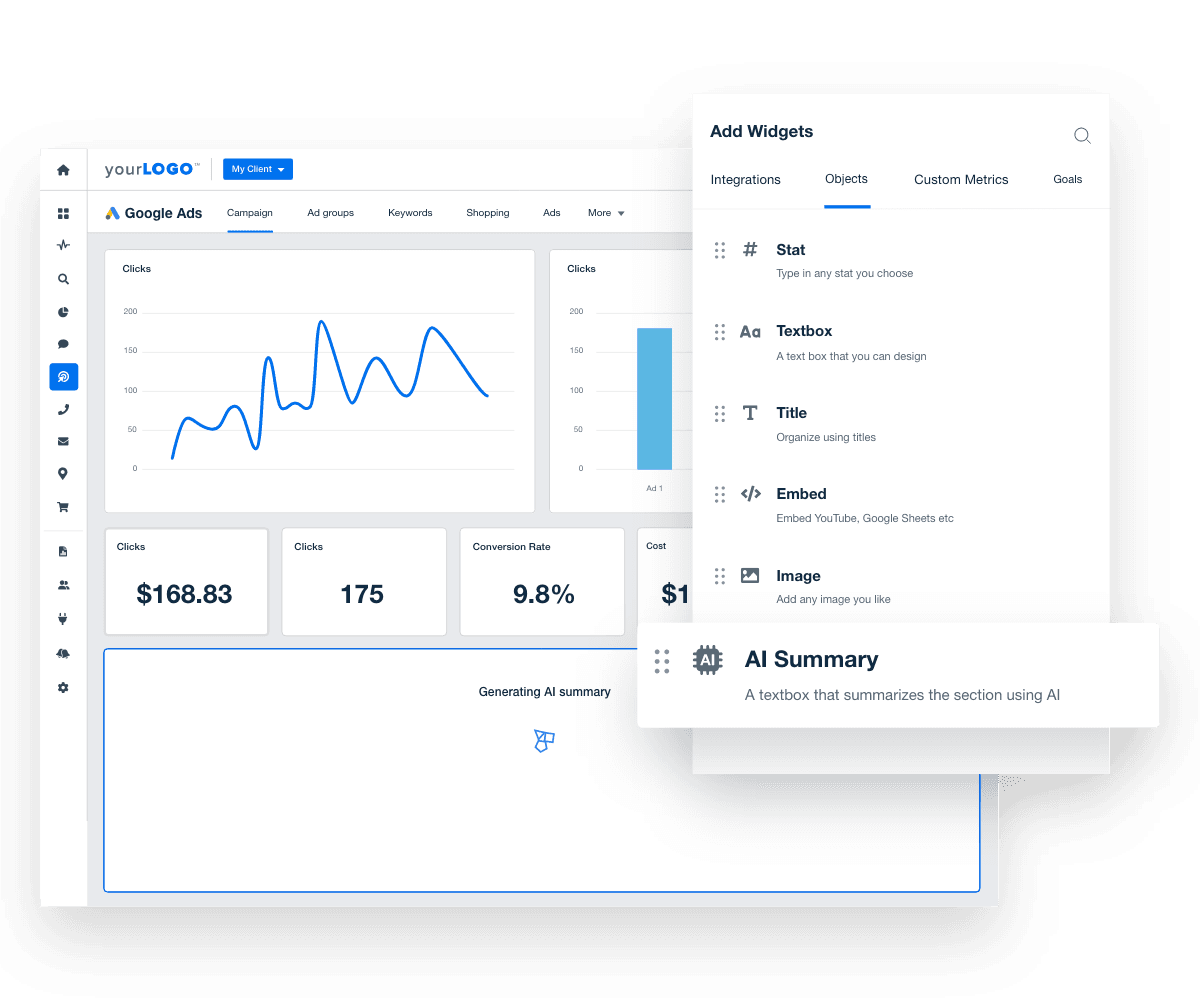
With AgencyAnalytics, leverage AI to draft a summary of your client report–highlight the wins, point to the opportunities, and prove your agency’s ROI in a fraction of the time. Try our AI features free for 14 days!
Impress clients and save hours with custom, automated reporting.
Join 7,000+ agencies that create reports in under 30 minutes per client using AgencyAnalytics. Get started for free. No credit card required.
Step 2: Test small, measure big
Don’t overhaul your whole system overnight. Test one tool on one client or one deliverable. Track things like time saved, clarity improved, and how clients respond. If it helps, keep it. If not, move on.
Step 3: Integrate, don’t stack
Automating reporting for clients with AI only works if it fits into the systems you already use. If they add more tabs, more exporting, or more steps, you’re just moving the chaos around. AgencyAnalytics connects with 80+ platforms to centralize your reporting, and it’s free to start.
Step 4: Revisit and refine
Teams change, clients shift priorities, and tools update overnight. Before you renew or roll anything out wider, take a minute to weigh the pros and cons of AI tools in marketing. Then set regular check-ins to see what’s working, what’s redundant, and where a human still needs to step in.
Final thoughts
Generative AI (and LLMs within that category) has a place in agency life, but as a brilliant assistant, not a creative director. These tools can draft, visualize, organize, and speed things up. What they can’t do is understand brand nuance, tense client politics, or that gut feeling when a number in a report is off. That part stays human.
Agencies using AI well aren’t using everything—they’re using it on purpose. The right tools, at the right point in the process, and the rest stays with the people on payroll.

Written by
Kali Armstrong is a freelance content writer with nearly a decade of experience crafting engaging, results-driven copy. From SEO blogs to punchy short-form pieces, she combines strategic insight with authentic messaging to captivate audiences and drive results.
Read more posts by Kali ArmstrongSee how 7,000+ marketing agencies help clients win
Free 14-day trial. No credit card required.



